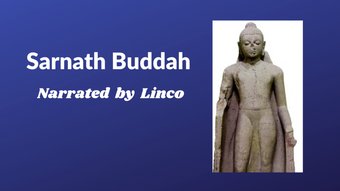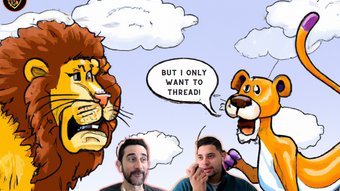Varendra Museum: Garuda (Narration of Garuda by Linco)
9
About :
A strong and youthful prince rises to greet the preserve of the universe. He is no ordinary mortal. He has the power to do what we all dream of doing-he can fly.
This Garuda was likely placed on the top of a stone pillar in front of a temple containing an image of Vishnu. Time has not treated this Pala dynasty Garuda kindly His pillar may have been toppled in a big earthquake or deliberately destroyed by invaders.

In the thousand years since he was sculpted he has lost his head and his arms, but examine him carefully-you can still find evidence of one of his wings.
Garuda is the eagle on which the Hindu god Vishnu rides when he must intervene in human affairs to prevent the forces of evil from gaining control of the world.
Is Indian art he is often depicted, as in this painting, with the body of a man but the head, wings, and tail of an Eagle.
In Nepal and Bangladesh, he traditionally depicted as a beautiful youth with the wings and tail of an Eagle as in this, famous Garuda in Nepal. Here he waits on a tall stone pillar before the temple of Krishna, an avatar of Vishnu.
Within a few meters of where you now stand you can find several examples of sculptures of the Hindu god Vishnu-Preserver of the Universe, and if you examine the sculptures carefully, you will find elegant examples of what this life-size Garuda would look like if restored. Compare the size of the Garuda in these sculptures to Vishnu. Now, imagine how big was the sculpture of Vishnu in the temple before which this Garuda once kneeled. Perhaps you will become the archaeologist who finds this sculpture of Vishnu! You and your find will become world-famous!

As early as 30,000 years ago, early hunters and gathers were painting and carving animals on rocks and in caves that were important to their survival. We see them hunting wild boar and deer and herding domesticated animals. Early hunters and gathers acquired an intimate knowledge of the behavior of wild animals, birds, and reptiles. They believed that everything that moved possessed a soul the same as humans and asked forgiveness any time they killed an animal for food or cut down a tree for wood.
4000 years ago, when the first cities in the Indian subcontinent arose along the great rivers of what is now Pakistan, India, and Bangladesh, they left behind not only clay toys, as you have seen in the Varendra Museum, they created small seals. Used on parcels of goods, the seal impressions have been found as far away as Bhairon and Central Asia. And on many of the seals, the artists have carved the most accurate depictions of animals created anywhere in the ancient world.
They told the first animal stories that would later be collected and elaborated as the Panchatantra. When the Muslims arrived they fell in love with the wisdom and humor of these animal stories. The Mogul rulers commissioned elaborately illustrated Persian translations of these stories, as depicted in this illustration of “The Tiger and the Fox.”
The historic Buddha, born at the foot of the Himalayas in the jungle of present-day Nepal, taught compassion and reverence for life by recounting his previous lives when he had come as a deer, a monkey, and in this illustration, as an elephant. These stories became known as the Jataka Tales and traveled to Southeast Asia and to China, Korea, and Japan where they were translated and beautifully illustrated.

As you continue your exploration of the sculptures in the Varendra Research Museum, be on the lookout for the hundreds of animals, real and imaginary, that decorate and give special meaning to Hindu, Buddhist, and Jain art.
Families, clans, and tribes choose animals they admired to be their symbol and erected totem poles with the animal carved of wood on top and placed the poles in front of their community halls and along the boundary of their territory. Whether the emperor Ashoka commissioned the stone pillars with their animal capitals or simply added his edicts to preexisting pillars of his neighbors is hotly debated by scholars.
When the gods of Vedic Hinduism arrived they took wives from among the local goddesses and a bird or animal on which to ride from among the animals revered by the local inhabitants, and in so doing, we're able to assimilate the beliefs of the inhabitants who came before them into Hinduism. In Hindu mythology, animals, and creatures part animal and part human, are sometimes heroes, sometimes demons, and as we will see, sometimes avatars of Vishnu, the Preserver.
Tags :
Their limit for today is $0!




























Comments:
Reply:
To comment on this video please connect a HIVE account to your profile: Connect HIVE Account